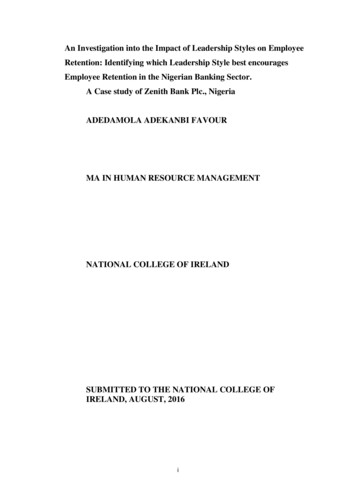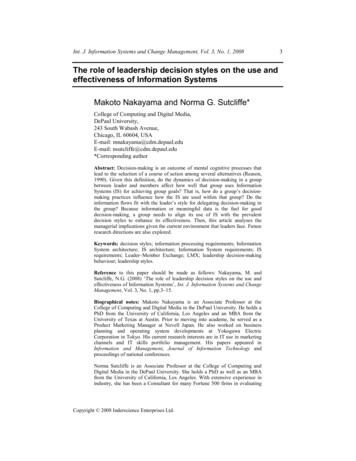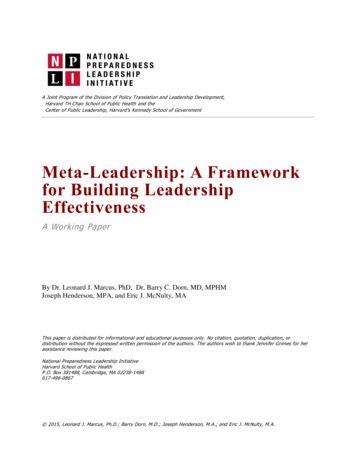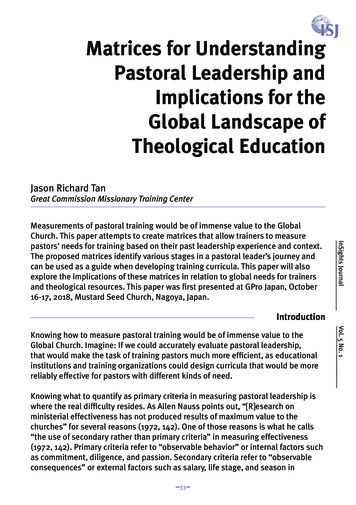
Transcription
UnderstandingLeadership StylesChecklist 256IntroductionWhilst there are numerous suggested leadership styles, the need to be authentic as a leader and to have astyle that suits you, your personality and the people you lead is widely accepted. Adopting an appropriatestyle is likely to build a good relationship between a leader and their team members, helping to establishrapport, trust and respect. Conversely, leaders who adopt or display an inappropriate style are unlikely to besuccessful in their job. Some employees may become disenfranchised, disengaged and uninspired whenfaced with a leader who lacks the self-awareness and know-how to pick the right kind of leadership style.Reflecting on how you lead is an essential aspect of being a good leader.Your ‘leadership style’ largely refers to how you deal with people, particularly those employees reporting toyou within your organisation. In his book Leadership Styles, Tony Kippenberger (See Additional Resourcesbelow) suggests that a less deferential and more egalitarian society has meant that there is now a need forleaders to actively assess and improve their style in order to engage followers.A shift away from manufacturing and heavy industry towards knowledge and service-based industries in theeconomies of many developed nations over the past few decades has also influenced leadership style. Morecollaborative and coaching styles are seen to be effective in encouraging the motivation and customer focuson which service industries depend.It is likely that it will be necessary to adapt your leadership style to a certain degree throughout your career todepending on the type of organisation you are employed by, your colleagues and your working environment.An awareness of differing leadership styles can help you decide which is appropriate for you and yourorganisation. This checklist describes some of the most popular theories of and approaches to leadershipstyles before going on to explore how being aware and thinking about leadership styles can be useful inpractice.Definition‘Leadership style’ is the general manner, outlook, attitude and behaviour of a leader, particularly in relation tohis or her colleagues and team members. This can be expressed in various ways including: what a leadersays; how they say it; the example they set; their body language; and their general conduct and character.Some models of leadership stylesRobert Tannenbaum and Warren H Schmidt: The Leadership ContinuumAn early contribution to the literature on leadership styles was made by Robert Tannenbaum and Warren HSchmidt back in the 1950s. They proposed the idea of a ‘leadership continuum’ consisting of seven stages.Each stage of the continuum involves a decreasing use of managerial authority alongside an increasing levelof subordinate freedom. The continuum progresses from the first stage, where the manager makes all theAll rights reserved. No part of this publication may be reproduced in a retrieval system, or transmitted, inany form or by any means, electronic, mechanical, photocopying, recording or otherwise, without theprior permission of the publisher.
decisions and announces them to their team to the final stage where the manager permits team members tofunction and make decisions within pre-designated limits.The different stages of the continuum effectively describe different leadership styles. Typically, leaders willmove through the continuum, giving more responsibility to their subordinates over time – assuming thesubordinates are willing to follow the direction of the leader and are performing at a suitable level.Tannenbaum and Schmidt acknowledged that style will vary depending on the leader, those who are led andthe situation, and leaders need to bear this in mind when choosing their style from the continuum.Whilst leaders may lose some degree of control as they move through the continuum it is important toremember that the leader is always ultimately accountable for the actions of their team. Therefore, movingthrough the continuum requires a significant level of trust between the leader and their team. Contemporaryleaders would be unlikely to regularly use the first, “command and control” style or stage to any great extent,and in most cases it should only be used as a last resort.Situational leadershipThe need to take account of the context or specific situation within which a leader is operating, was exploredin more detail by Paul Hersey and Ken Blanchard. Their situational leadership theory followed on from thework of Bill Reddin who developed a 3-D model of management style (See Related Models below) and hasbeen updated and refined several times.As the name suggests, situational leadership theory states that different situations call for different leadershipstyles. Leaders need to be ready to adjust their style to suit the context. This relates largely to thecompetence and development level of other team members.Four leadership styles (directing, coaching, supporting and delegating) are classified according to the level ofsupportive and directive behaviour required in that situation. Supportive styles of leadership tend to involvetwo-way communication. Concepts such as social and emotional support, praising and listening areimportant. In contrast, directive styles of leadership tend to involve one-way communication from the leaderto their colleagues and the focus is on providing clarity, goals and direction.The diagram below, based on a redefinition of the four types of leadership by Peter Cumpstey and Philip Lindsay,illustrates how they are affected by supportive and directive behaviour and the development level of followers.PARTICIPATING (Non-Directive)COACHINGHIGHRELATIONSHIP FOCUSL2L3L LEADERSHIP STYLE OF LEADERL1L4LOWDELEGATINGINSTRUCTINGTASK FOCUSHIGHLOWR READINESS LEVEL OF LEARNERR1No CompetenceLow ConfidenceR2Some CompetenceIncreasing ConfidenceR3Moderate CompetenceVolatile ConfidenceR4High CompetenceHigh ConfidenceFrom Pathways Plus Strategic Management and Leadership Level 7: Being a Strategic Leader/Strategic Leadership Practice, CharteredManagement institute, revised ed. 2010, page 69. Reproduced by permission.All rights reserved. No part of this publication may be reproduced in a retrieval system, or transmitted, inany form or by any means, electronic, mechanical, photocopying, recording or otherwise, without theprior permission of the publisher.
Action-centred leadershipAnother situational approach to leadership is action-centred leadership, made famous by John Adair. Actioncentred leadership is perhaps more of an approach than a style, but it is very widely-taught and used byleaders globally, particularly in the United Kingdom.Adair suggests that leaders need to be attentive to task needs, group needs and individual needs. The mosteffective leaders balance all three areas, as demonstrated by the Venn diagram below. However, the leadermay need to vary the degree of emphasis given to each of the three components in response to the situationat any point in time.Transactional leadershipIn the 1970s and 1980s the transactional model of leadership was dominant. This is based on an exchangebetween leader and follower where the interests of both parties are served. The efforts made by followers toachieve organisational aims are exchanged for specific rewards, which may be financial or non-financial.Whilst the idea of transactional leadership may lack the dynamism of other approaches, it may well be thecase that it accurately describes practice in many workplaces. Additionally, this kind of leadership can beparticularly effective in emergency or conflict situations when all parties are able to see a tangible benefit.Bernard M Bass felt that effective leaders needed to exercise two transactional elements: contingent rewardand management by exception. Contingent reward refers to the agreed exchange process between leadersand followers (e.g. leaders giving a salary or a bonus, in exchange for the efforts and hard work of theirfollowers); whilst management by exception is characterised by corrective criticism and giving feedbackwhen things go wrong.Transformational leadershipThe term ‘transformational leadership’ was first used by James V Downton in 1973 and was popularised byJames MacGregor Burns in his 1978 book Leadership. It remains the predominant leadership approach inthe literature and has also had a significant impact on the way that modern leaders behave.Transformational leadership involves the engagement of followers and therefore transformational leaders areoften charismatic. Accounts of transformational leaders differ, but most focus on how the leader can fulfil thedevelopment needs of their followers. In uncertain times, it has been suggested, employees want to feelinspired and empowered by their leaders, and therefore transformational leadership fits well with the modernage.There has been a huge amount of writing devoted to transformational leadership over the past two to threedecades, so the focus here will be on the key thinkers:All rights reserved. No part of this publication may be reproduced in a retrieval system, or transmitted, inany form or by any means, electronic, mechanical, photocopying, recording or otherwise, without theprior permission of the publisher.
Bernard M Bass and Bruce J AvolioIn an echo of Robert Tannenbaum and Warren H Schmidt’s work, Bass devised a leadership continuum,from transformational leadership to laissez-faire leadership, with transactional leadership in the middle.Transformational leadership, for him, involved four factors:1. Idealised influence/charisma: The leader is a strong role model whom followers seek to emulate.Leaders have strong moral and ethical principles and as a result, are well-respected.2. Inspirational motivation: Followers are encouraged to do more than the bare minimum due to theinspirational communication and high expectations provided by the leader.3. Intellectual stimulation: The leader encourages followers to be creative, innovative and tochallenge their own beliefs and those of the organisation.4. Individualised consideration: A supportive climate is provided with coaches and advisors assistingfollowers. Delegation is encouraged to support the development of employees.James M Kouzes and Barry S PosnerJames M Kouzes and Barry S Posner describe five factors of excellent leadership that they believe anyonecan learn to incorporate into their leadership approach:1. Model the way: be clear about your values and philosophy2. Compelling vision: you need to create a vision that followers can use to guide both their day-to-daybehaviour and their own dreams and visions3. Challenge the process: willingness to challenge the status quo and innovate is seen as key4. Enable others to act: collaborate, trust and encourage others5. Encourage the heart: authentic reward and recognition is also seen as important.Warren Bennis and Burt NanusThe qualities of a transformational leader were identified by Bennis and Nanus as:1. Having a clear vision for the future2. Being “social architects” for their organisations: communicating a direction and form for theirorganisations that others could follow3. Trust created by consistency and clarity: leaders need to make their positions clear and stand bythem4. Positive self-regard: this is about having an awareness of your strengths and weaknesses – but thenconcentrating on what you’re good at, rather than dwelling on your weak points.Transformational leadership is thus seen by all these authors as being characterised by certaincompetencies and qualities. Common themes of these qualities include: having a vision, emotionalintelligence, charisma and being consistent and clear.Authentic leadershipRecent corporate, financial and governmental scandals and misconduct have also led to a growing interest inthe related idea of authentic leadership. This focuses on being genuine, honest and trustworthy in yourleadership style. Authentic leaders must ‘live their values,’ showing that they practise what they preach, inorder for their followers to see them as authentic. An important aspect of an authentic leadership style is selfknowledge, although there is also a strong emphasis on knowing others and knowing your organisationalculture. This enables you to strike the right balance between being an authentic, true version of yourself andfitting in to your company or organisation. Key writers on authentic leadership include Rob Goffee andGareth Jones, and Bill George.All rights reserved. No part of this publication may be reproduced in a retrieval system, or transmitted, inany form or by any means, electronic, mechanical, photocopying, recording or otherwise, without theprior permission of the publisher.
Action checklist1.Know yourselfThere are numerous questionnaires and tests that organisations and individuals can use to evaluateleadership styles. One of the most famous is the Multi Factor Leadership Questionnaire (MLQ) developed byBernard M Bass, but there are many others available online and in printed formats. For an in-depthevaluation of your leadership style, consider discussing your style with a trusted colleague or coach for asecond opinion.2.Know your teamConsider your team members in turn and what kind of style might suit them. Their time in post andexperience will influence how much support and guidance they need. Are they happy to be delegated to ordo they need a lot of direction? If you are new in your leadership post, you may find that your team is used toworking autonomously, or you may find that they need a lot of guidance. Consider whether what has beendone before is the best way forward, and which style will help the team with any new challenges or changesthat are on the horizon.You will need to be careful not to pre-judge people, but at the same time take into account that there may begenerational or cultural differences in some cases. For example, it has been argued that members of“Generation Y” (a term usually used to refer to individuals born in the 1980s and 1990s) have differentexpectations of the workplace than the generation that preceded them (“Generation X”). It has beensuggested that they are typically seeking fulfilment at work – not just a pay cheque – and therefore tend toprefer leaders and managers who put time and effort into their development by coaching and mentoringthem. Employees of all ages are likely to be less accepting of a ‘command and control’ style nowadays, andare likely to want some input and a voice in decision-making.3.Consider the contextA number of factors are likely to be crucial when considering the right leadership style for your organisation.Is it a private company or a not-for-profit voluntary or governmental organisation? Is it currently doing wellfinancially and/or succeeding as a company? Is it currently undergoing a lot of change? Is it a small start-upor a huge multinational conglomerate? These and many other questions are likely to influence the kind ofleadership style to adopt.4.Share best practice with your teamOther people in your team may already be leaders or may aspire to a leadership position in the organisation.Even those with no leadership responsibilities or plans to take a managerial role at your organisation may beable to act as leaders, even in junior positions. Openly discussing the right kind of leadership approach totake, and sharing your knowledge of leadership styles will be beneficial to everyone. You may be surprisedby what the members of your team say they are looking for in a leader. Open discussion can also help toclarify what people can expect from you as a leader and help build rapport between yourself and your team.5.Continue to evaluate your leadership styleWhichever leadership style you adopt, it’s unlikely to be the case that you stick with that style throughoutyour career. Take some time every few months to consider whether the leadership style you have adopted isworking out for you and whether it can be adjusted or changed to make things better. Be prepared to vary itaccording to the situation, rather than having a single style all the time. One of the most important aspects ofleadership is the ability to reflect honestly and question yourself, so effective evaluation of your leadershipstyle should contribute to better leadership practice.Managers should avoid failing to reflect upon the effect of their style on their colleaguessticking to one style rigidly regardless of situation and contextnot being authentic and true to themselves in whichever style they adoptAll rights reserved. No part of this publication may be reproduced in a retrieval system, or transmitted, inany form or by any means, electronic, mechanical, photocopying, recording or otherwise, without theprior permission of the publisher.
National Occupational Standards for Management and LeadershipThis checklist has relevance for the following standards:Unit AA1: Manage yourselfUnit AA2: Develop your knowledge, skills and competencesUnit BA2: Provide leadership in your area of responsibilityAdditional resourcesBooksLeadership theory and practice, Peter G NorthouseThousand Oaks, Calif: Sage, 2013We are all leaders: leadership is not a position – it’s a mindset, Fredrik ArnanderChichester: Capstone, 2013This title is also available as an e-bookthThe leadership challenge: how to make extraordinary things happen in organisations, 5 ed, James MKouzes and Barry S PosnerSan Francisco, Calif: Jossey-Bass, 2012This title is also available as an e-bookA very short, fairly interesting and reasonably cheap book about studying leadership, 2Jackson and Ken ParryLondon: Sage, 2011nded, BradA manager’s guide to leadership: an action learning approach, Mike Pedler, John Burgoyne and TomBoydellLondon: McGraw-Hill, 2010This title is also available as an e-bookWhy should anyone be led by you?: what it takes to be an authentic leader, Rob Goffee and GarethJones, 2006Boston, MA: Harvard Business School PressthThe Bass handbook of leadership: theory, research and managerial implications, 4 ed, Bernard MBass and Ruth BassNew York NY: Free Press, 2008Leadership styles, Tony KippenbergerOxford: Capstone, 2002Test your leadership skills, Brian O’NeillLondon: Hodder and Stoughton, 2000Effective leadership: a modern guide to developing leadership skills, revised ed., John AdairPan: London, 1988Leadership and the one minute manager, Kenneth Blanchard, Patricia Zigarmi and Drea ZigarmiLondon: Collins, 1986Leaders: the strategies for taking charge, Warren Bennis and Burt NanusNew York NY: Harper & Row, 1985This is a selection of books available for loan to members from CMI’s library. More information at:www.managers.org.uk/libraryAll rights reserved. No part of this publication may be reproduced in a retrieval system, or transmitted, inany form or by any means, electronic, mechanical, photocopying, recording or otherwise, without theprior permission of the publisher.
Journal ArticlesHow to choose a leadership pattern, Robert Tannenbaum and Warren H SchmidtHarvard Business Review, Mar/Apr 1958 vol 36 no 2, pp95-101This article is available to download from CMI’s library. More information at www.managers.org.uk/library.Related checklistManagement styles (236)Related modelsAdair’s Action-Centred LeadershipReddin’s 3D style modelSituational leadershipTannenbaum & Schmidt leadership continuumTransformational leadershipThis is one of many checklists available to all CMI members. For more information please contactt: 01536 204222e: enquiries@managers.org.ukw: www.managers.org.ukChartered Management InstituteManagement House, Cottingham Road, Corby NN17 1TT.This publication is for general guidance only. The publisher and expert contributors disclaim all liability forany errors or omissions. You should make appropriate inquiries and seek appropriate advice before makingany business, legal or other decisions.Revised November 2013All rights reserved. No part of this publication may be reproduced in a retrieval system, or transmitted, inany form or by any means, electronic, mechanical, photocopying, recording or otherwise, without theprior permission of the publisher.
important. In contrast, directive styles of leadership tend to involve one-way communication from the leader to their colleagues and the focus is on providing clarity, goals and direction. The diagram below,











